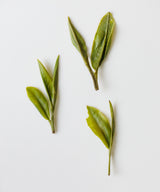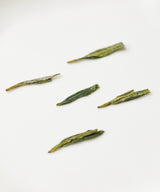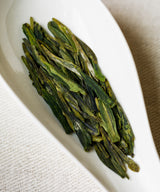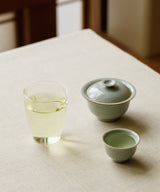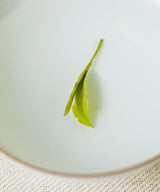Master Tang’s Dragonwell Longjing
唐小軍白鶴峰龍井
Harvest
April 9, 2025
Origin
Baihefeng, Hangzhou, Zhejiang
Let us introduce you to a notorious tea that we, incidentally, rarely carry, because we just can’t settle for anything other than the most authentic version when it comes to Dragonwell tea.
The true name of Longjing is actually Xihu Longjing or “West Lake Dragonwell.” Xihu refers to West Lake in Hangzhou, a mesmerising lake surrounded by beautiful classical gardens, pagodas, and temples with hills and mountains framing three of its sides.
This terroir is of fundamental importance to Longjing tea. Following tradition, the core producing region of Longjing in Xihu is divided into five areas that correspond to the mountains: Shi (Lion), Long (Dragon), Yun (Cloud), Hu (Tiger), Mei (Mume). Our Longjing is from Baihefeng, or “White Crane Peak,” which belongs to the Long (Dragon) subdivision of the region, 6 km southwest of Xihu West Lake.

The uniqueness of Longjing from Baihefeng is a result of both the soil and cultivar of the tea plants. The soil on Baihefeng is unique: a white, sandy soil composed mostly of pebble-sized fragments of white quartzite, which has been weathered and eroded. Thus, it is very rich in the minerals that are absorbed by the roots of the tea plants.
The cultivar is an indigenous varietal called Quntizhong. This is an inherited cultivar, more traditional than the commonly used, Longjing 43. Quntizhong dates back more than 1000 years ago, to the Qing Dynasty, meaning this tea tastes very much like old-style Longjing that ancestors would have enjoyed.
Our Dragonwell is crafted by the one and only tea master, Tang Xiaojun. Tang is famous for crafting the finest and most historically accurate Dragonwell entirely by hand. Each year, he makes a very limited quantity of handcrafted Dragonwell for sale.
The leaves for this tea were picked on April 9, 2025, as the colder than usual temperatures this year delayed tea harvest from high elevation farms by roughly 2 weeks. Each experienced tea picker is only able to pick around 1000g of fresh leaves each day on account of the rigorous picking standards. Once harvested, the fresh leaves are set out on a bamboo mat and withered for 4-8 hours, depending on the temperature, humidity, and the amount of sunlight each day. The leaves are then pan fried in small batches for two rounds.
The first round, known as the “kill-green” process, usually lasts for 10 minutes, and is used to hand-shape and flatten the leaves. The second round lasts around 30 minutes, during which the experience of the tea maker is crucial, as a series of different gestures and movements are required throughout this process - shaking, pushing, holding, pressing and rubbing - all while the pan is at an extremely high temperature of 300°C. This technique takes years of experience to perfect, and when mastered, ensures the finished tea has a better aroma and less astringency.
After pan frying, the leaves are aged with limestone in a large earthenware vessel for 5 days. This is an important step in making traditional Longjing, as the limestone helps absorb any remaining moisture in the leaves without absorbing the tea’s aroma with it.
The result of all of this is a tea we can’t encourage you more enthusiastically to try. You will notice right away that Dragonwell tea leaves appear flat and broad. This is from the hand shaping that happens in the pan frying stages. They pile on top of one another in the gaiwan like narrow sheets of paper, and open quickly as soon as they meet water, becoming vibrant and dimensional, like images in a picture book.
Their liquor looks like melted quartz or glacier run off: a clear, icey green that reminds us of the mountain lake around which these tea leaves grew. It has a soft, delicate mouthfeel that increases in density and unity through infusions. In terms of tasting notes, its elegance is in its quietness, but we do get distinct hints of jungle flowers, orchids, and water plants. In light of this tea’s gentleness on the palate one would not expect it to deliver the amount of energy that it does. Its energy builds slowly and gently in the core of us as we drink it through infusions. The pleasant heat and stimulation moves strength and excitation through to the tip of every limb.
Truly, this is not a tea to underestimate, on any level.
Brewing guide
| Tea | 3g |
| Temperature |
80 °C |
| Water | 120ml |
| Steep time | 5 - 90 sec |
| No. of infusions | 7 |

